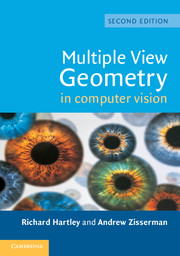Book contents
- Frontmatter
- Contents
- Foreword
- Preface
- 1 Introduction – a Tour of Multiple View Geometry
- PART 0 The Background: Projective Geometry, Transformations and Estimation
- PART I Camera Geometry and Single View Geometry
- PART II Two-View Geometry
- PART III Three-View Geometry
- PART IV N-View Geometry
- PART V Appendices
- Bibliography
- Index
PART II - Two-View Geometry
Published online by Cambridge University Press: 25 January 2011
- Frontmatter
- Contents
- Foreword
- Preface
- 1 Introduction – a Tour of Multiple View Geometry
- PART 0 The Background: Projective Geometry, Transformations and Estimation
- PART I Camera Geometry and Single View Geometry
- PART II Two-View Geometry
- PART III Three-View Geometry
- PART IV N-View Geometry
- PART V Appendices
- Bibliography
- Index
Summary
Outline
This part of the book covers the geometry of two perspective views. These views may be acquired simultaneously as in a stereo rig, or acquired sequentially, for example by a camera moving relative to the scene. These two situations are geometrically equivalent and will not be differentiated here. Each view has an associated camera matrix, P, P′, where′ indicates entities associated with the second view, and a 3-space point X is imaged as x = P′X in the first view, and x′ = P′X in the second. Image points x and x′ correspond because they are the image of the same 3-space point. There are three questions that will be addressed:
(i) Correspondence geometry. Given an image point x in the first view, how does this constrain the position of the corresponding point x′ in the second view?
(ii) Camera geometry (motion). Given a set of corresponding image points {xi ↔ x′i}, i = 1, …, n, what are the cameras P and P′ for the two views?
(iii) Scene geometry (structure). Given corresponding image points x ↔ x′ and cameras P, P′, what is the position of (their pre-image) X in 3-space?
Chapter 9 describes the epipolar geometry of two views, and directly answers the first question: a point in one view defines an epipolar line in the other view on which the corresponding point lies.
- Type
- Chapter
- Information
- Multiple View Geometry in Computer Vision , pp. 237 - 238Publisher: Cambridge University PressPrint publication year: 2004
- 3
- Cited by



